Time:2025-07-11
The Rise of Flexible Neon Strips in Commercial Design
In the competitive landscape of modern business, flexible neon strips have emerged as a transformative solution for commercial lighting, blending aesthetic versatility with functional durability. From retail stores and hospitality venues to corporate offices and outdoor advertising, these innovative lighting systems offer businesses the ability to create dynamic, brand-centric environments that adapt to diverse architectural and operational needs. Engineered to combine the iconic glow of traditional neon with advanced LED technology, flexible neon strips are redefining how commercial spaces use light to engage customers, enhance brand identity, and optimize operational efficiency.
This article explores the technical innovations, strategic advantages, and real-world applications of flexible neon strips in commercial settings, providing a comprehensive guide for businesses and designers seeking to leverage these systems for impactful and adaptable lighting solutions.
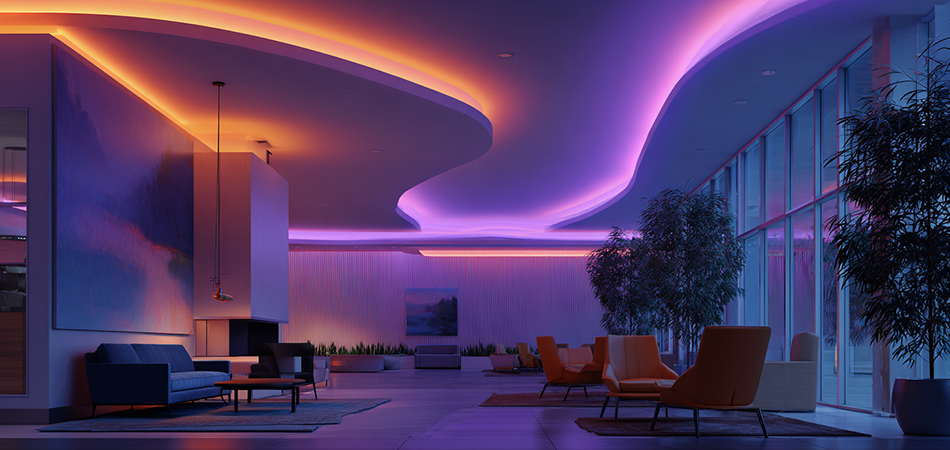
Technical Foundations: Engineering for Commercial Excellence
Adaptive Design for Diverse Commercial Environments
Flexible neon strips are purpose-built to meet the rigors of commercial use, combining durability with creative flexibility:
Premium Material Construction
High-Grade Silicone/PVC Encapsulation: Outer casings made from UV-stabilized silicone (for outdoor resilience) or fire-retardant PVC (for indoor safety), resisting fading, moisture, and mechanical stress. Silicone variants offer superior flexibility, capable of withstanding 10,000+ bend cycles without cracking, while PVC options provide a cost-effective solution for low-exposure commercial zones.
Reinforced PCB Substrates: Flexible printed circuit boards embedded with fiberglass or polyimide, ensuring consistent conductivity even after repeated shaping around complex commercial structures like curved storefronts or irregular display units.
LED Technology for Commercial-Grade Performance
High-Luminance LED Arrays: Surface-mounted LEDs designed to deliver vibrant, uniform illumination across long strips, with density options tailored for different commercial needs—from subtle ambient lighting to high-visibility signage.
Color Calibration Precision: Advanced wavelength-matching technology ensures accurate reproduction of brand colors (Pantone/RGB), critical for maintaining visual consistency in multi-location commercial chains.
Low-Voltage Safety and System Integration
Dual-Voltage Compatibility: Operates on 12V/24V DC, compatible with commercial power grids, battery backups, or solar systems, reducing electrical risks in public spaces.
Smart Control Ready: Built-in drivers support integration with DMX512, Bluetooth, or Wi-Fi controllers, enabling remote adjustment of brightness, color, and lighting effects—ideal for large-scale commercial installations.
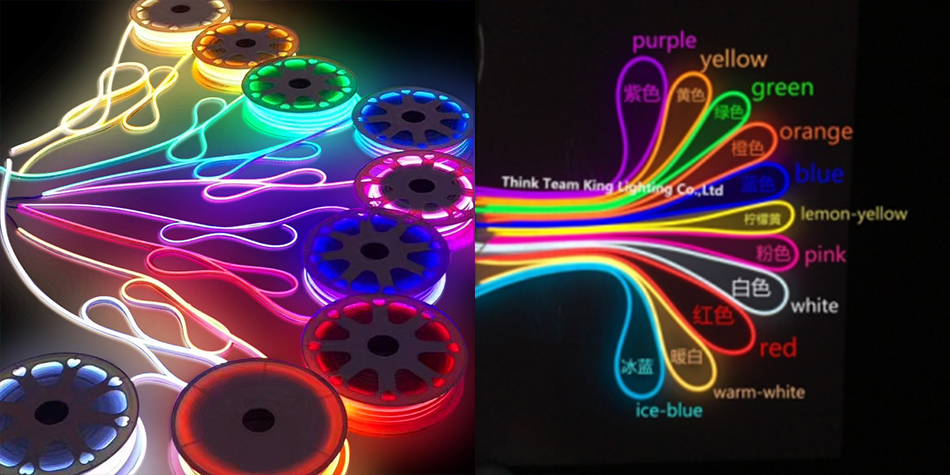
Core Advantages for Commercial Applications
Unmatched Design Flexibility
Architectural Conformity: Easily bends around columns, arches, and custom millwork (minimum bend radius 20–30mm), transforming structural elements into illuminated brand features.
Modular Customization: Pre-marked cut points and universal connectors allow quick adaptation to any space, from small boutique displays to expansive mall installations, with no soldering required for segmenting or joining strips.
Durability for High-Traffic Environments
Impact and Vibration Resistance: Engineered to withstand daily wear in busy commercial zones, with reinforced connectors and shock-absorbent mounts that resist accidental collisions in retail aisles or hospitality venues.
Weatherproof Performance: IP65/IP67-rated variants for outdoor use, protecting against rain, dust, and UV radiation, while indoor strips meet fire safety standards (UL 94-V0) for compliance in office buildings and retail spaces.
Energy Efficiency and Cost Savings
Low Power Consumption: Consumes up to 70% less energy than traditional neon or halogen lighting, reducing operational costs for 24/7 commercial operations.
Long Operational Life: 50,000+ hours of maintenance-free performance, minimizing replacement frequency and associated labor costs in hard-to-reach commercial ceilings or high-bay areas.
Ease of Installation and Retrofitting
Tool-Free Setup: Adhesive-backed strips or magnetic mounts enable rapid installation on diverse surfaces (glass, metal, drywall), reducing downtime during store renovations or seasonal display updates.
Cable Management Solutions: Flat, flexible cables and discreet connectors ensure a clean aesthetic, even in visibility-critical commercial areas like storefronts or reception desks.
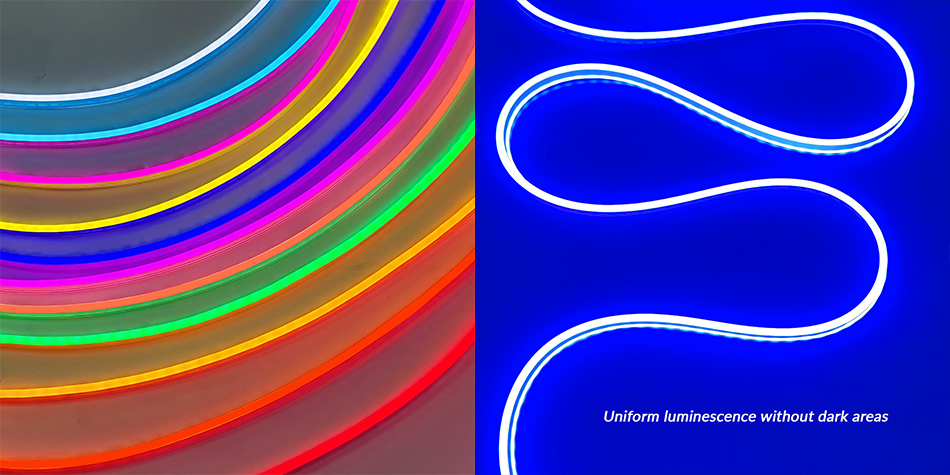
Strategic Applications Across Commercial Sectors
Retail: Enhancing Brand Visibility and Customer Experience
Storefronts and Signage
Logo Illumination: Custom-shaped neon strips outlining brand logos on storefronts, ensuring 24/7 visibility with weatherproof designs that withstand urban environments.
Window Displays: Flexible strips along shelf edges or mannequin bases, highlighting products with vibrant, shadow-free light that adapts to seasonal merchandise rotations.
In-Store Navigation and Zoning
Aisle and Product Zone Markers: Colored neon strips (e.g., blue for electronics, green for organic products) guiding customers through retail layouts, improving wayfinding and dwell time.
Interactive Displays: Dimmable or color-changing strips in experiential retail zones, synced with digital displays or motion sensors to create engaging product showcases.
Hospitality: Crafting Memorable Guest Experiences
Restaurants and Bars
Bar Counter Accents: Neon strips along counter edges or liquor shelves, adding modern elegance while improving visibility for bartenders and guests. Dimmable warm white variants create intimate dining atmospheres, while RGB options match themed events or happy hour vibes.
Hotel Lobbies and Suites: Wrapping neon around architectural features like columns or chandeliers, enhancing luxury aesthetics with customizable color schemes that align with the hotel’s brand identity.
Event Venues and Conference Centers
Modular Stage Lighting: Flexible strips on trusses or backdrops, easily reconfigured for weddings, galas, or corporate events, with remote-controlled color changes to match event themes.
Wayfinding in Large Venues: Illuminated path markers and room numbers, improving guest navigation in convention centers or multi-level event spaces.
Corporate Offices: Balancing Aesthetics and Functionality
Branding and Reception Areas
Backlit Logos and Wall Art: Neon strips behind corporate logos or abstract wall installations in reception areas, creating professional first impressions with soft, uniform backlighting.
Open Office Zoning: Colored strips separating work zones (e.g., red for meeting areas, blue for focus zones), enhancing spatial organization in modern open-plan offices.
Task and Ambient Lighting
Desk and Shelf Lighting: Slim-profile neon strips under cabinets or along desk edges, providing adjustable task lighting with low heat emission, ideal for shared workspaces.
Conference Room Ambiance: Dimmable strips along ceiling coffers, adapting from bright meeting modes to relaxed presentation settings with seamless control integration.
Outdoor Commercial Spaces
Billboards and Advertising Displays
Flexible Neon for Dynamic Ads: Wrapping around outdoor billboard frames or building facades, creating eye-catching outlines or animated effects that comply with local signage regulations.
Parking and Transit Hubs: Colored strips along parking garage edges or transit station canopies, improving safety and visibility with durable, weatherproof designs.
Hospitality Exteriors
Restaurant Patio Lighting: Weatherproof strips along pergolas or outdoor dining barriers, enhancing evening ambiance while withstanding rain and temperature fluctuations.
Hotel Facades: Neon outlines of architectural features on building exteriors, transforming hotels into local landmarks with programmable color schemes for holidays or events.
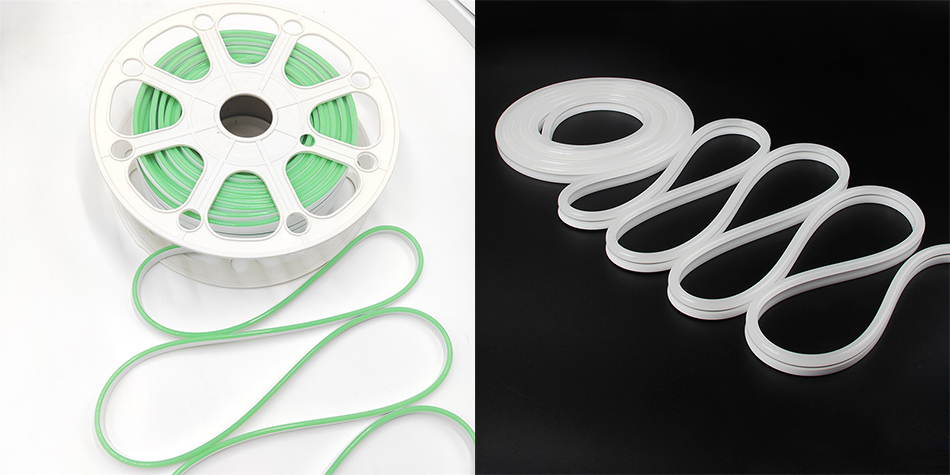
Design and Installation Best Practices for Commercial Settings
Phase 1: Commercial Space Analysis
Environmental Mapping:
Indoor Spaces: Assess fire codes, ambient light levels, and architectural features (curves, heights) to select appropriate strip types (e.g., fire-retardant PVC for offices, silicone for high-moisture kitchens).
Outdoor Areas: Evaluate exposure to sunlight, wind, and rain to specify IP ratings (IP67 for coastal locations, IP65 for urban storefronts) and UV-resistant materials.
Brand and User Journey Alignment:
Collaborate with designers to map brand colors and lighting moods, ensuring neon strips enhance visual storytelling—e.g., warm tones for hospitality, cool whites for retail clarity.
Phase 2: Material and System Selection
Performance Prioritization:
High-Impact Zones: Choose silicone-encased strips with metal-reinforced connectors for retail aisles or hospitality corridors.
Aesthetic Focus Areas: Opt for slim-profile PVC strips with diffused light for subtle backlighting in art galleries or luxury boutiques.
Power and Control Integration:
Large Commercial Sites: Use centralized DMX controllers for synchronized lighting across multiple zones, with surge protectors to safeguard against power fluctuations.
Portable Setups: Battery-powered or solar-charged systems for pop-up shops or temporary commercial activations.
Phase 3: Installation Techniques
Secure Mounting for Commercial Structures:
Glass and Metal Surfaces: High-strength adhesive or magnetic mounts for easy removal and reuse, critical for rental commercial spaces.
Concrete and Brick Walls: Mechanical clips or rivets for heavy-duty outdoor installations, spaced every 15–20cm to ensure stability.
Cable and Connector Management:
Conceal wiring within architectural features (e.g., moldings, false ceilings) to maintain a clean look, using color-matched cables for seamless integration.
Position connectors in non-visible areas (e.g., behind displays or within structural columns) to avoid disrupting the commercial aesthetic.
Phase 4: Testing and Maintenance
Pre-Launch Checks:
Verify color accuracy with brand guidelines using professional colorimeters, ensuring uniformity across all installed strips.
Test control systems for remote functionality, dimming ranges, and emergency backup compatibility (e.g., battery power for outages).
Routine Commercial Maintenance:
Indoor Strips: Monthly cleaning with non-abrasive solutions to remove dust and fingerprints, preserving light transmission.
Outdoor Strips: Quarterly inspections for connector seals and casing wear, with annual UV resistance testing to prevent color fading.
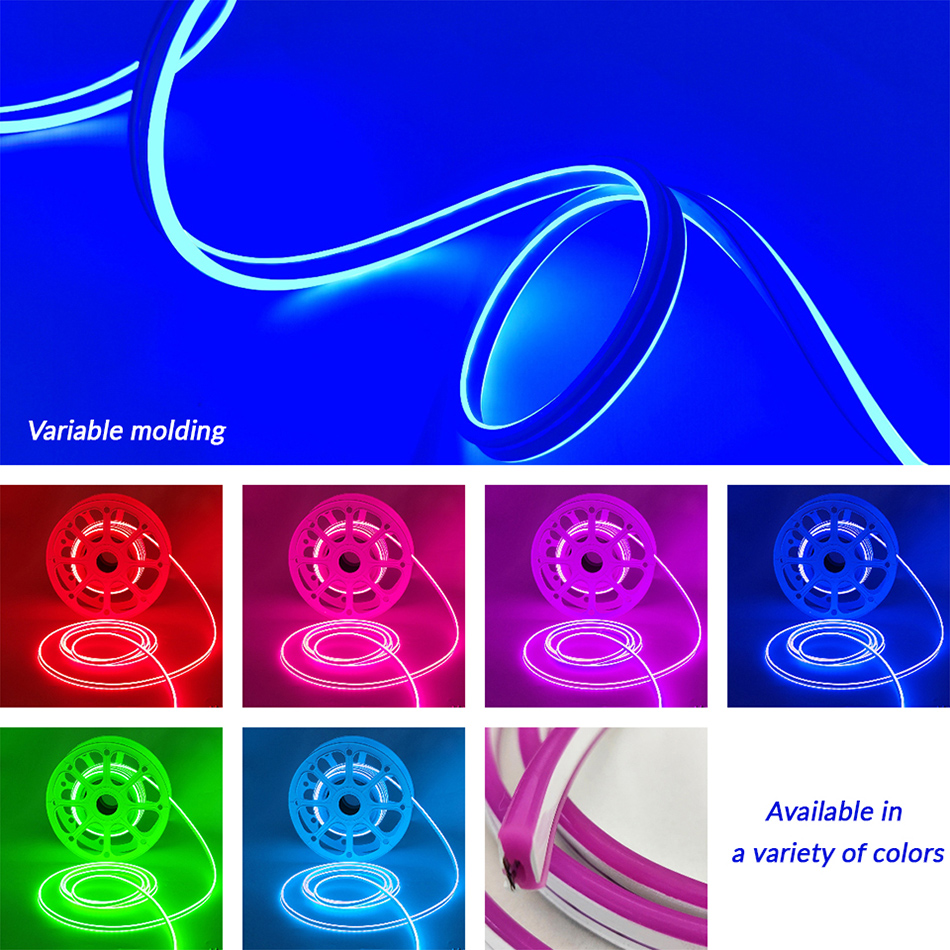
Key Considerations When Selecting Commercial Flexible Neon Strips
Environmental Adaptability
Temperature Range: Ensure strips operate efficiently in the commercial space’s typical conditions (e.g., -10°C to 40°C for most indoor venues, -30°C to 60°C for extreme outdoor environments).
Chemical Resistance: Silicone strips for spaces exposed to cleaning agents (restaurants, hospitals); PVC for dry, low-contamination offices or retail stores.
Lighting Performance Criteria
Brightness and Beam Angle: Higher LED density (60+ LEDs/m) for high-visibility commercial zones; lower density for ambient lighting in hospitality or corporate settings.
Color Rendering Index (CRI): Prioritize CRI >85 to accurately display products and skin tones, essential for retail apparel stores or beauty salons.
Certification and Compliance
Safety Standards: Mandatory certifications include UL 1838 (Sign Lighting) for outdoor use and CE EN 60598 for indoor installations, ensuring compliance with local electrical and fire codes.
Sustainability Goals: RoHS-compliant strips for eco-conscious commercial spaces, with optional recycled material casings for LEED-certified buildings.
Supplier and Service Excellence
Commercial Project Experience: Partner with suppliers who have a portfolio of similar installations (e.g., retail chains, hotel brands) and offer custom bending or pre-fabrication services.
Technical Support: Choose vendors providing on-site installation training, remote troubleshooting, and extended warranties (2–5 years) to minimize commercial downtime.
Overcoming Commercial Lighting Challenges
Challenge 1: Maintaining Brand Color Consistency Across Locations
Solution: Source all strips for a commercial chain from the same manufacturer and production batch, using digital color-matching tools during the design phase.
Challenge 2: Vibration-Induced Failures in High-Traffic Areas
Solution: Use anti-vibration mounts and redundant connectors in retail aisles or hospitality corridors, with quarterly inspections to tighten loose fittings.
Challenge 3: Complex Architectural Shapes
Solution: Engage suppliers with 3D modeling capabilities to pre-bend strips for unique commercial structures, such as circular reception desks or angular storefronts.
Challenge 4: Energy Efficiency in 24/7 Operations
Solution: Integrate motion sensors or daylight harvesting systems to auto-dim strips in low-occupancy commercial zones, reducing energy waste without compromising visibility.
Innovations Shaping Commercial Neon Lighting
Smart Commercial Lighting Ecosystems
IoT-Enabled Control: Cloud-based platforms allowing multi-location businesses to manage lighting schemes remotely, with real-time analytics for energy usage and performance monitoring.
Proximity-Activated Effects: Strips that change colors or brightness when customers approach, enhancing engagement in retail checkout zones or hospitality lobbies.
Sustainable Commercial Solutions
Recycled Material Innovations: Strips made with 30% post-industrial recycled silicone, appealing to eco-conscious brands and reducing commercial carbon footprints.
Energy-Harvesting Models: Solar-powered neon strips for outdoor commercial signage, ideal for remote locations or businesses aiming for net-zero energy use.
Advanced Design and Integration
Transparent Neon Strips: New variants with invisible connectors and clear casings, enabling seamless integration into glass storefronts or transparent commercial displays.
Projection-Mapping Compatibility: Flexible neon as a base layer for augmented reality projections in retail windows or event venues, creating layered visual experiences.
Conclusion: Flexible Neon Strips as a Commercial Asset
Flexible neon strips have evolved into a strategic asset for commercial spaces, offering a rare combination of design flexibility, durability, and energy efficiency that meets the diverse needs of modern businesses. From enhancing brand visibility in retail to crafting immersive experiences in hospitality, these systems empower commercial environments to adapt, engage, and innovate—all while maintaining cost-effective, sustainable operations.
As commercial design continues to prioritize customer experience and operational efficiency, flexible neon strips stand out for their ability to transform spaces without compromising on performance or compliance. By investing in high-quality, certified systems and leveraging supplier expertise, businesses can elevate their commercial environments—proving that versatile, durable lighting is not just a feature, but a foundation for success in competitive markets.